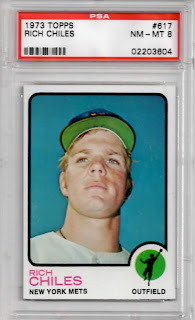1970 TOPPS METS ROOKIES #348 GAI 8
Lean in closely-- today I'm going to whisper about a curse.
It is a curse somewhat obscure in its application, but devastating nonetheless.
It is the curse of the two-player 1970 Topps rookie cards.
Five different players on these split-level cards died before they reached the age of 40.
Fortunately, the two Mets players pictured here were not affected.
Mike Jorgensen left the Mets for the Expos in April of 1972 as part of the package that brought Rusty Staub to Flushing. Mike had some productive years as a starter for Montreal, and he even boomeranged back to the Mets in the early '80s, serving largely as a lefty bat coming off the bench. Mike's career lasted for 17 seasons, and he is currently a member of the Cardinals' front-office staff.
Jesse Hudson pitched in one big-league game in his career, a two-inning mop-up stint in the nightcap of a Pirates' double-header sweep of the Mets in September, 1969. Jesse is still alive today, but he remains an elusive autograph for collectors trying to complete a set of signatures from everyone who spent time on the Mets' roster during that wondrous 1969 campaign.
Now here's a rundown of the players who were not so lucky...
Thurman Munson

The most prominent player on the list, Munson died while piloting a Cessna Citation in the summer of 1979. He was 32.
News of his death came to us in a suburban Long Island basement while we were playing Mattel Electronic Football or listening to Bat Out of Hell or doing some other 1979-type thing. We were Mets' fans, but we were crushed by the news, and his death tore the ornery heart out of the Yankees. Champions in 1977 and 1978, they would not win the Series again until 1996...
Carl Morton

To this day, Carl Morton remains the only MLB player with whom I've had a face-to-face conversation.
It happened along the third-base rail at Shea Stadium, about an hour before a 1972 Mets/Expos game. I was among a small clutch of kids waving programs at the visiting Expos' players asking for autographs, when Morton walked over.
He grabbed my program and my pen and signed his name quickly. Then with a broad grin on his face, he said, “Y'all read your bible now, son. It's a good book, y'hear?”
I muttered “Yessir,” took the program back from him, and traced over his signature with my finger. His name bisected a puffy cumulus cloud that floated over Shea in the fish-eye lens stadium photo on the program's cover.
Morton, the 1970 National League Rookie of the Year, died of a heart attack in 1983 at the age of 39.
Randy Bobb

Randy Bobb had one hit in 10 career at bats with the Cubs, a 4th inning single off Ron Reed of the Braves on August 21, 1968. Bobb was replaced by Randy Hundley in the top of the 6th of that game with the score tied at 5-5, and the Cubs went on to win 13-5, with Billy Williams driving in seven runs.
Bobb spent 1970 bouncing around AAA with the Cardinals, Brewers, and finally, the Mets. He went on to appear with Tim Foli on a 1971 Mets rookie card, but he was never again able to ascend to the majors. His career came to a close in 1973, after splitting the season with a couple of AA teams.
Randy died in 1982 at the age of 34 as a result of injuries suffered in a car accident.
Herman Hill

Hill did Randy Bobb one better and scored two career hits. However, it took him 24 at bats to do so, leaving him with a lifetime batting average of .083.
Both hits came in the same game, a 5-4 Twins victory over the Royals on June 29, 1970. Hill singled twice off Dick Drago, and came around to score both times.
Hill was traded to the Cardinals in October of 1970, and traveled to Venezuela to play winter ball that same year. He drowned while swimming near the city of Valencia, at the age of just 25.
Miguel Fuentes

Miguel Fuentes earned a September, 1969 call up with the Seattle Pilots after having a dominant campaign for the Class A Clinton Pilots. He went 8-2 for Clinton with a 1.46 ERA, pitching mostly in relief.
He showed flashes of promise with the big club, including a complete-game 5-1 victory over the White Sox. While this September 8, 1969 contest would turn out to be Miguel's only MLB win, he is also noteworthy for having thrown the final pitch in Seattle Pilots history. He worked a clean 9th inning in the team's 3-1 loss to Oakland on the final day of the 1969 season-- eventually, the Pilots became the Brewers and the franchise moved to Milwaukee to start the 1970 season.
Fuentes was shot three times in a bar fight in January of 1970, and died as a result at the age of 23.

















